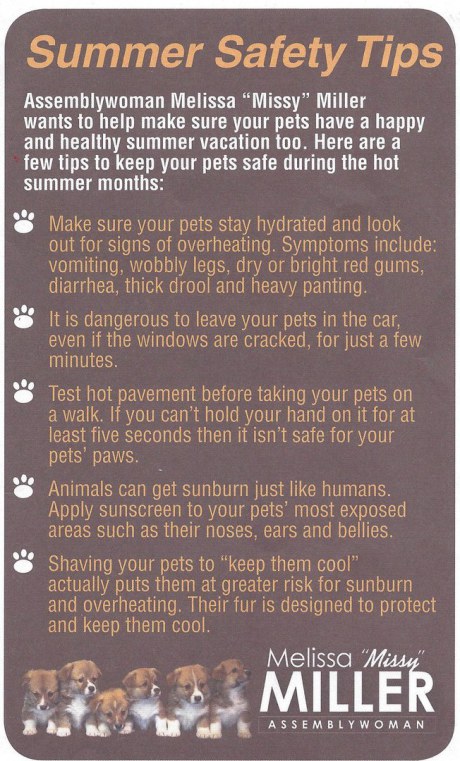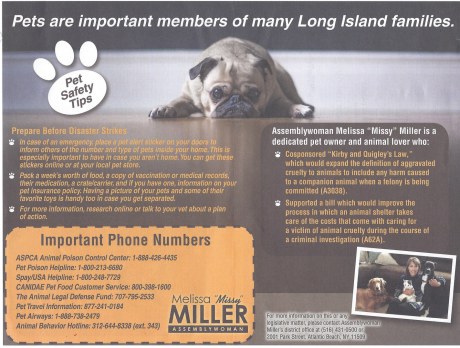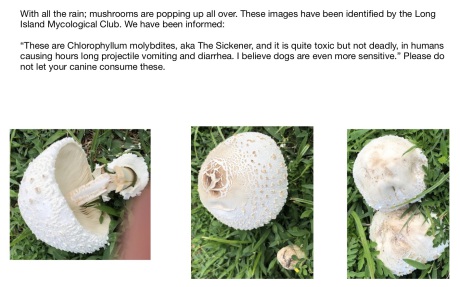Warm weather pet safety
You might know that cold weather poses health risks to your pets, but so does warm weather – even on days that don’t seem that hot to you. Knowing the risks and being prepared can help keep your pet safe.
Be prepared
-
Talk to your veterinarian about warm weather risks for pets (and travel safety if you plan to travel with a pet).
-
Make sure your pets have unlimited access to fresh water, and access to shade when outside.
-
Keep your pet free of parasites that are more common during warm weather, such as fleas, ticks and heartworm.
-
Ask your veterinarian how to recognize signs of heat stress.
Keep pets at home
-
Leave your pets at home if possible when you need to go out and about.
-
Provide different temperature zones within your house for your pet’s comfort.
-
Never leave a pet in the car, even in the shade or with windows cracked. Cars can overheat quickly to deadly temperatures, even when the weather isn’t severe.
Keep them comfortable
-
If it’s hot outside for you, it’s even hotter for your pet.
-
Take walks, hikes or runs during the cooler hours of the day.
-
Avoid hot surfaces, such as asphalt, that can burn your pet’s paws.
-
Ask your veterinarian if your pet would benefit from a warm-weather haircut or sunscreen.
Exercising with your pet
-
Consult your veterinarian prior to starting an exercise program for your pet. Overweight pets and short-nosed dog breeds have higher risk of problems with warm-weather exercise.
-
Don’t walk, run or hike with a dog during the hottest parts of the day or on particularly warm days.
-
Take frequent breaks.
-
Bring enough water for both you and your pet.
Garden and yard safety
-
Make sure the plants in your garden and yard are safe for pets.
-
Store lawn fertilizer and insecticides out of reach of your pets.
-
Always follow safety instructions on lawn and garden products, particularly the instructions on how long you should keep pets out of the treated areas.
-
If you use a lawn service, make sure they are aware that you have pets.
-
Avoid using cocoa bean mulch, which contains the same pet toxin found in chocolate.
7 Foods to Avoid Feeding Your Dog or Cat
If any of these are consumed; call your veterinarian as soon as you know it has happened.

- Xylitol-containing products (xylitol is an artificial sweetener often found in sugar-free candy and gum and other foods to decrease the sugar intake);
- Chocolate (although some types of chocolate are not as toxic as others, it's safer to keep your pet away from all types of chocolate);
- Onions;
- Grapes and raisins;
- Fatty and fried foods;
- Macadamia nuts
- Avocados
7 Foods to Avoid Feeding Your Dog or Cat
If any of these are consumed; call your veterinarian as soon as you know it has happened.

- Xylitol-containing products (xylitol is an artificial sweetener often found in sugar-free candy and gum and other foods to decrease the sugar intake);
- Chocolate (although some types of chocolate are not as toxic as others, it's safer to keep your pet away from all types of chocolate);
- Onions;
- Grapes and raisins;
- Fatty and fried foods;
- Macadamia nuts
- Avocados
Leptospirosis "Lepto" is a disease caused by infection with Leptospira bacteria. Some of the ways your pet can get "Lepto" is by eating grass where infected animals have been. Ask the doctor how you can safegard your pet today.
Don't forget to have your dog tested for heartworm diease. Heartworms are transmitted by the bite of a mosquito. The larva primarily reside and cause damage to the blood vessels of the lungs. Remember to call for an appointment and don't forget tto ask about fleas and ticks.
Outdoor cats are exposed to a variety of viruses (especially rabies) and therefore need to be protected against these dieases.
In puppies and kittens parasites rob your pet of healthy development and in some cases are transmitted to humans. Bring a stool sample at your next visit.
I have noticed a rise in Leptospirosis. Call me to discuss if your pet should be vaccinated against this bacteria.
Call for an appointment today.
<< 7 Things to keep your pet safe for Halloween>>
7 Things You Can Do to Make Halloween Safer for Your Pet
- Don't feed your pets Halloween candy, especially if it contains chocolate or xylitol (a common sugar substitute found in sugar-free candies and gum);
- Make sure your pet is properly identified (microchip, collar and ID tag) in case s/he escapes through the open door while you're distracted with trick-or-treaters;
- Keep lit candles and jack-o-lanterns out of reach of pets;
- If you plan to put a costume on your pet, make sure it fits properly and is comfortable, doesn't have any pieces that can easily be chewed off, and doesn't interfere with your pet's sight, hearing, breathing, opening its mouth, or moving. Take time to get your pet accustomed to the costume before Halloween, and never leave your pet unsupervised while he/she is wearing a costume;
- Keep glow sticks and glow jewelry away from your pets. Although the liquid in these products isn't likely toxic, it tastes really bad and makes pets salivate excessively and act strangely;
- If your pet is wary of strangers, or has a tendency to bite, put him/her in another room during trick-or-treating hours or provide him/her with a safe hiding place;
- Keep your pet inside.
Wtih the rain; mushrooms are everywhere!




